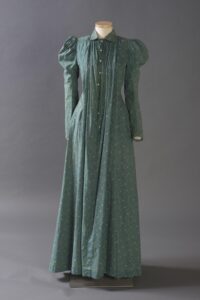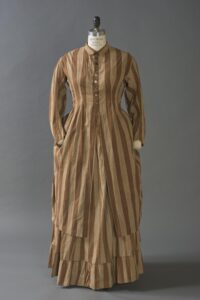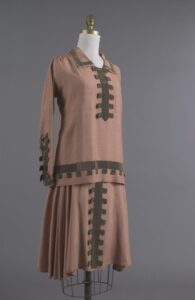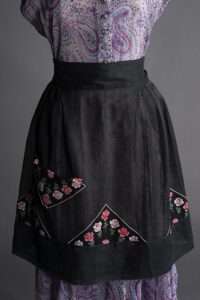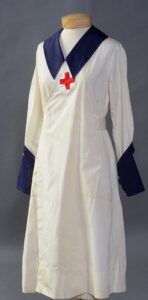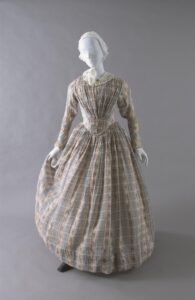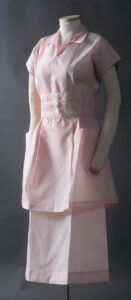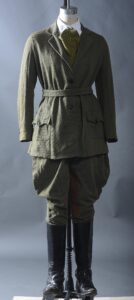“An intense invitation to the use of the historical imagination.”
Faculty Teaching Experiences
In order to learn more about how the Smith College Historic Clothing Collection has been used as a teaching resource across the college, I spoke with Professor of English, Richard Millington and Professor of French, Jonathan Gosnell about their experiences including the collection in their course material.
- How and when did you find out about the Smith College Historic Clothing Collection?
- When and why did you decide to use the collection in your teaching?
- How have you used the collection in your teaching?
- Do you think it was beneficial to your teaching and supplemental to your students’ learning?
- What kind of feedback did you receive from students?
- What do you see as the broader value of the collection? What do you hope to see happen moving forward?
Richard Millington, Professor of English
In the Fall of 2012, Professor Millington began teaching a First Year Seminar focused around the year 1925 to explore the transition from Victorian to modernist American culture. A portion of this course aimed to use historical writing to look at the ideas of modernism emerging for women surrounding changes in dress and style, and what that expressed. In developing this course, Professor Millington decided to utilize the Smith College Historic Dress Collection as a way to give students a way to take part in the hands-on study of material culture. The collection helped students to visualize shifts in external presentation through dress as a way to consider the changing cultural values of the 1920’s.
Professor Millington expressed that engaging with the collection helped students to make connections to the material because it was something that they could immediately relate to. He called the experience “an intense invitation to the use of the historical imagination.” In recalling the student response he received, Professor Millington said that this experience seemed to spark an interest in many students who continued to have interest in working with the collection following this course.
In regards to his hopes for the collection’s future, Professor Millington communicated that he thought it would be beneficial for Smith to find ways to incentivize faculty engagement with the collection. he suggested the possibility of implementing summer research grants to encourage faculty research of the Smith College Historic Clothing Collection as the College has done in the past with its other institutional collections.
Jonathan Gosnell, Professor of French
In the Fall of 2015, Professor Gosnell began teaching a course focused around a 19th century novel by Émile Zola to explore the impact of the department store in France. The novel demonstrated that department stores gave all classes access to taste and culture. Professor Gosnell chose to use the Smith College Historic Clothing Collection as part of this course to get students thinking about what women were wearing in the 19th century and how clothing related to changes in labor, purchasing power and the idea of a disposable income, social class, etc. The collection helped to visualize the transformation of people’s lives as they worked and were able to purchase.
Professor Gosnell expressed that integrating the collection into this course seemed like a perfect fit because “the garments speak for themselves.” He explained that the exposure he had to the collection through teaching this course influenced his own personal research and encouraged him to do further inquiry. However, he noted that unless students or faculty know about this collection and request to visit it, they might not ever get the chance to work with it. Professor Gosnell suggested that there be more regular exhibitions of collection materials to increase exposure to both members of the Smith community and the wider public. Similarly to Professor Millington, he also proposed College-funded research grants as an option for advancing engagement.
Courses Taught Using the Collection*
Professor Kiki Smith: THE 154 “Reading” Dress: Archival Study of Clothing
Course Description: “This course is an introduction to a methodology for the study of dress as material culture, examining physical structures, terminology, technology of clothing production, as well as some of the historical, social and cultural variables shaping – and shaped by – clothing. It is a hands-on class using garments from the Smith Historic Clothing Collection. Students work in small teams to study several similar garments, identifying common features as well as distinctions that may reflect different classes, aesthetic choices and industrial influences.”
Professor Jonathan Gosnell: FRN 230 Colloquium in French Studies — Consumers, Culture and the French Department Store
Course Description: “How have French stores and shopping practices evolved since the grand opening of Le Bon Marché in 1869? In what ways have megastores influenced French “culture”? This course examines representations of mass consumption in literature, the press, history, and analyses of French popular and bourgeois traditions, paying particular attention to the role of women in the transactions and development of culture.”
Professor Richard Millington: FYS 192 America in 1925
Course Description: “Reading, discussions and student projects explore the transformation of a “Victorian America into a “modernist” one by focusing on forms of expression and sites of conflict in 1925 – the year of Fitzgerald’s The Great Gatsby, Bessie Smith’s “St. Louis Blues,” Alain Locke’s The New Negro, Chaplin’s The Gold Rush, the Scopes evolution trial, and the emergence of powerful new ideas in the social sciences – to cite just a few examples.”
Professor Cornelia Pearsall: ENG 365 Victorian Mourning and Memorialization
Course Description: “Victorians mourned and marked their dead with elegies and stone angels, novels and black ostrich plumes. This course studies the representation and commemoration of the dead in literature, art and social practice. Readings from poetry, fiction, theory and etiquette books, in the context of mourning attire from Smith’s Historic Clothing Collection and a range of objects from other archives. Particular attention to ways in which grief intersected with Victorian discourses of gender, sexuality, race and class.”
*This is not an exhaustive list of past and current classes taught using the Smith College Historic Clothing Collection
